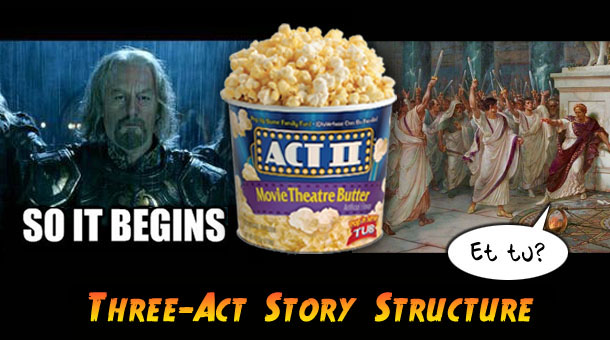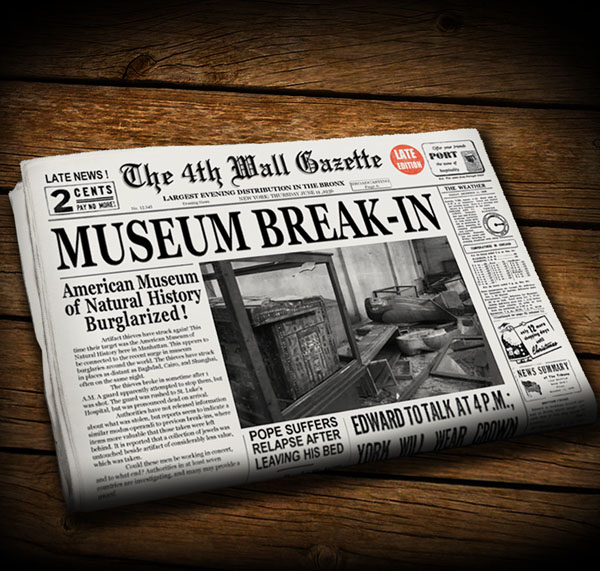June 11, 2017
Three-Act Story Structure in Interactive Fiction

Mark and I decided that we wanted Harrowing Adventures to be a great interactive fiction game and to also read like a story that fits a traditional narrative even though the players are making decisions to control the course of the story. We’re using the three-act structure to help guide us.
What is Three-Act Story Structure?
Three-act story structure, when reduced to its essence, breaks a story into three parts: a beginning, middle, and end (Thanks, Aristotle). If you want a more in-depth explanation, keep reading. Three-act structure offers a guide for what story elements are expected by Western audiences in traditional narratives and when those elements are expected. Stories from other cultures cannot always be easily mapped by three acts, but not all popular Western stories can either. No Country for Old Men and Forrest Gump are two tales that don’t feel particularly unusual, nevertheless, they don’t break easily into three acts.
The three-act structure is just a tool for thinking about stories. It may or may not help you write one, but if problems arise in your plotting it can often give you a lens through which to diagnose them. Because the three-act structure details what an audience expects from a story and when, a writer can use it to either provide what the reader expects or pointedly subvert those expectations. It maps a series of guideposts that the story passes along the way or makes a deliberate point to avoid.
The first act makes up the first quarter of the story. It introduces the characters, establishes the setting. It lays the groundwork for an intriguing story and then kicks off the action with an inciting incident. The protagonist is introduced, she gets into a mess, and then the story is set on its way. The first act ends and the second begins when she runs into a significant complication and realizes that the problem she was trying to solve is much bigger than or perhaps fundamentally different from what she believed.
The second act usually spans about half of the story. This is the middle part where the protagonist tries and fails to accomplish her goals, and her failures make things worse. The act ends when she’s in a seemingly hopeless situation. However, the things that she has been doing and learning are probably the very things that will be important for her to reach the conclusion and be successful. She may not realize it yet, though.
Finally, the third act takes up the last quarter of the story. It’s the battle from the low point to victory.
So in the first half of the story, the protagonist is asking questions and reacting to her situation. In the second half (midway through the second act), she’s finding answers and taking action.
Three-act structure isn’t the only way to think about stories. There are four-act structures, seven point structures, etc. But most stories written with similar guiding techniques in mind can still can be mapped onto three acts. The three-act structure has also been worked into specific forms like The Hollywood Formula. It goes so far as to dictate page numbers in a script where certain events should happen.
 Many writing formulas map very closely to the basic three-act structure.
Many writing formulas map very closely to the basic three-act structure.
Three-Act Structure in Interactive Fiction?
There is always some structure in interactive fiction. At the very least, you’ll have some goal or problem given to you at the beginning of a story, and then you’ll set about trying to find a satisfying ending. Often there are “winning” endings that satisfy your desire for the story to come out well to various degrees, and then there are the “losing” endings that leave you somewhat unfulfilled. Too often much of the content feels like a series of disconnected trials you must overcome on your way to your goal. Maybe you find a magic sword, and maybe it helps you defeat the end boss, but it’s rarely the case that the struggles you face feel intimately married to the exciting conclusion. Like Jason’s quest for the Golden Fleece, the tale turns into just one damned thing after another until you’re done. It doesn’t have to feel like that.
On the other hand, there is also the danger of feeling railroaded—when the author has decided that their story is so essential that you’ll be forced to “play” through it in its purest form. In this case the player doesn’t feel enough agency within the story. It doesn’t have to be that way either.
Harrowing Adventures
From the beginning we’ve loved the idea of a player creating a story that is exciting to experience as a game and enjoyable to read as a novel. No problem, we just have to maximize two variables simultaneously and we’re all set. That was sarcasm. It’s a tough problem. People struggle just to make a fun game or make a good book. We’re setting out to try to do a single thing that passes as both. That’s bad enough, but we’re also making a three-player game, which means we have to make three good books, and three fun games, and then tie them all together.
So how is it possible to allow a player to play a game, make independent decisions, and still fit a good story format? I’ve been involved with roleplaying game evenings that have spiraled into exercises in pointless distractions and tedious fidgeting. As we’ve discussed before, it’s no secret that you have to rely on tricks to constrain player options in interactive fiction, and that’s okay. Because you control all the options that are presented, you can avoid a the situation where players are able to do anything nutty thing they can imagine. You must, however, have choices that feel fundamentally differentiated and offer lots of variety in the possible outcomes.
We want Harrowing Adventures to have a definite beginning, middle, and end for every player. We’re using the three-act structure to help us define where those story beats are. That way we make to make sure we hit them. A lot of the fun of outlining this game comes from figuring out different paths that the story can take that will all scratch all the right storytelling itches and yet all feel distinct from one another. Every branch of the outline must fit a version of the structure. Ultimately, it all comes down to play testing.
We also have to make sure that a player can succeed or fail at various points in the story, and that neither breaks our story structure. That brings us to fail states.
The Fail State
Fail state problems are hard for many reasons. For one thing, you can’t often make a failed game feel like it has been a good story. Who is excited to read the story of the daring vampire hunter who battled his way halfway through Dracula’s castle only to miss a jump and drown in the sewers below? Nobody, that’s who!
Fortunately, we have lots of plans in the works for dealing with fail states. We’ll talk about those a lot more in the future, but I can say a few things here. For one thing, minor fail states aren’t a problem. There is a try-fail cycle built into the second act. Minor failures are to be expected and actually enhance the gameplay experience by ratcheting up the tension.
What about major, game-ending failure states? The nature of interactive fiction provides us with much more control over where major fail states are possible. In Castlevania, every open pit and every monster is a possible portal to the ultimate fail state. In interactive fiction, those portals are explicitly controlled by us. If you were to lose a gunfight in Harrowing Adventures, it wouldn’t necessarily mean you’d have to die on the spot. It might just mean that the course of your story had changed dramatically, and that there would be consequences.
Three Acts Everywhere!
I wouldn’t write a series of novels relying this heavily on this structural tool. But with a branching narrative game, there’s so much spaghetti to lose control of. In the end, we don’t think it will come out feeling as though we have been heavy-handed in our application of the three-act structure. That said, we’ve definitely looked at this game with the three-act trifocals on. Each individual episode makes a stab at feeling like a complete three acts, as does the collection of episodes that complete the story arc. Our single-player prologue does too, with a twist. The prologue will be free online in the coming months. We’ve also written out a rough plan for how this series will go. If we get to finish them all, the four books that would make up the series also fit themselves into each quarter of the three act structure: Act 1, first half of act 2, second half of act 2, act 3.
Hopefully, I haven’t led you to believe that we think that three act structure is some kind of magical story-telling panacea. I mostly wanted to impart that we’re doing everything in our power to make this feel like that adventure novel you don’t want to put down, even though you’re the one calling the shots.
If you have questions, we have answers. Leave a comment below.

